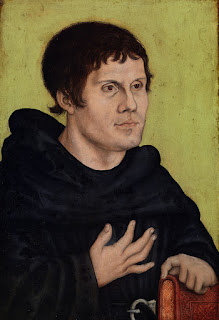WHO IS MARTIN LUTHER – 2
Early Catholic Images of Luther
Pope Leo X (1513-1521) asked the Augustinians to look into the Augustinian German priest who was disseminating “novas res… nova dogmata” among the faihtful.
The Dominicans in Germany, sympathizing with Johann Tetzel their confrere and archenemy of Luther on the matter of the sale of indulgences, started preaching about this “heretic” to the people, warning them that this man undermined religious practice and departed from standard Catholic teaching. Further, they surmised about his eventual disgraceful defeat and possible death at the stake.
Later attempts to apprehend Luther through canonical process showed that he was to be tried as a “suspect of heresy.” The pope, ordering an upgraded process of inquiry on the man and his teachings wrote that Luther was a known and obstinate “teacher of heresy.” (Jared Wicks, Roman Reactions to Luther, 1983, p. 528)
Dominican Cardinal Cajetan, the man who was to represent Rome in evaluating the orthodoxy of the positions of Luther, exhibited moral reserve against immediately issuing a judgement on Luther, although he instinctively found censurable points in the German’s thoughts. Cajetan’s final evaluation, added to the obstinacy judged from Luther’s own behavior during the examinations, however surely had a powerful effect on the definitive actions to come through the papal pronouncement of Pope Leo X.
Catholic Images of Luther in Documents
The official church portrait of Luther came through the two papal responses to the crisis caused by the Augustininan from Germany and the increasing number of princes and people he later influenced. On June 15, 1520, the pope issued a warning to Luther, identifying 41 erroneous teachings in his theological opinions. The papal bull, Exsurge Domine, called Luther the “new Porphyry.” (Porphyry was an ancient neoplatonic enemy of the early Christians, who pointed out the defects of Christian beliefs and taught the Jesus must be regarded only as a learned philosopher.) This official document likened Luther to heretics who employed malicious sophistry to advance their cause.
But in a compassionate note, the papal missive referred to Luther as the “prodigal son” who could still be received kindly once he realized his need for reconciliation with the church. Pope Leo gave Luther time to reconsider his positions and to signify his desire to submit to ecclesiastical authority by renouncing his convictions.
When Luther refused to comply with the demand for submission, Pope Leo X issued a second papal bull, this time, condemning Luther as a heretic and therefore, excommunicating him from the Body of Christ. The title of the bull says it all: Decret Romanum Pontificem of January 3, 1521 is the document “On the Condemnation and Excommunicaton of Martin Luther, the Heretic and his Followers.”
In this document, Luther is described as a “slave of depraved mind” for insisting on confessing beliefs at variance with traditional doctrines. As an excommunicate, Luther received the most severe penalty that can be imposed by the Church on its members. He was to be excluded from the reception of the sacraments, and impeded from enjoying the spiritual bond with the Church’s teaching, sanctifying and pastoral offices.
The Council of Trent, convoked in 1545 to respond to the Reformation crisis, did not mention Luther by name, although some of that Council’s declarations of anathemas were directed to principles put forward by Luther and his followers. In the Council however, strictly followed was the principle that no author should be denounced unless his writings have been subjected to the most accurate and sedulous study.
Prior to the Council, a catalogue of erroneous Lutheran tenets were compiled by Luther’s literary opponents. Johann Cochlaeus produced a list of 500 errors, while Johann Faber collected more than 600 false teachings of Luther.
